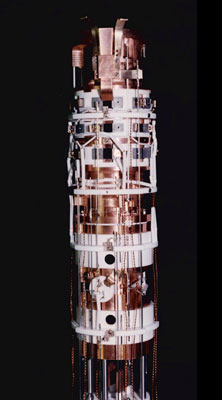| Posted: September 1, 2010 |
Researchers use small crystal of ions to detect forces at the yoctonewton scale |
|
(Nanowerk News) Physicists at the National Institute of Standards and Technology (NIST) have used a small crystal of ions (electrically charged atoms) to detect forces at the scale of yoctonewtons. Measurements of slight forces—one yoctonewton is equivalent to the weight of a single copper atom on Earth—can be useful in force microscopy, nanoscale science, and tests of fundamental physics theories.
|
 |
| The NIST force sensor is a crystal of ions (charged atoms) trapped inside the upper region of the copper cylinder. A laser beam directed upward through the trap cools the ions. A force is applied in the form of an oscillating electric field, and a detector (not shown) measures the light reflected off the ions.
|
|
A newton is already a small unit: roughly the force of Earth's gravity on a small apple. A yoctonewton is one septillionth of a newton (yocto means 23 zeros after the decimal place, or 0.000000000000000000000001).
|
|
Measurements of vanishingly small forces typically are made with tiny mechanical oscillators, which vibrate like guitar strings. The new NIST sensor, described in Nature Nanotechnology ("Ultrasensitive force and displacement detection using trapped ions"), is even more exotic—a flat crystal of about 60 beryllium ions trapped inside a vacuum chamber by electromagnetic fields and cooled to 500 millionths of a degree above absolute zero with an ultraviolet laser. The apparatus was developed over the past 15 years for experiments related to ion plasmas and quantum computing. In this case, it was used to measure yoctonewton-scale forces from an applied electric field. In particular, the experiment showed that it was possible to measure about 390 yoctonewtons in just one second of measurement time, a rapid speed that indicates the technique's high sensitivity. Sensitivity is an asset for practical applications.
|
|
The previous force measurement record with this level of sensitivity was achieved by another NIST physicist who measured forces 1,000 times larger, or 500 zeptonewtons (0.0000000000000000005 newtons) in one second of measurement time using a mechanical oscillator ("Nanomechanical motion measured with an imprecision below that at the standard quantum limit"). Previous NIST research indicated that a single trapped ion could sense forces at yoctonewton scales but did not make calibrated measurements.
|
|
The ion sensor described in Nature Nanotechnology works by examining how an applied force affects ion motion, based on changes in laser light reflected off the ions. A small oscillating electric field applied to the crystal causes the ions to rock back and forth; as the ions rock, the intensity of the reflected laser light wobbles in sync with the ion motion. A change in the amount of reflected laser light due to the force is detectable, providing a measure of the ions' induced motion using a principle similar to the one at work in a police officer's radar gun. The technique is highly sensitive because of the low mass of the ions, strong response of charged particles to external electric fields, and ability to detect nanometer-scale changes in ion motion.
|
|
The research was funded in part by the Defense Advanced Research Projects Agency. The first author, M.J. Biercuk, did the work as a post-doctoral researcher at NIST and is now at the University Sydney in Australia. Co-author H. Uys did the work as a NIST guest researcher and has since returned to the Council for Scientific and Industrial Research, Pretoria, South Africa.
|

